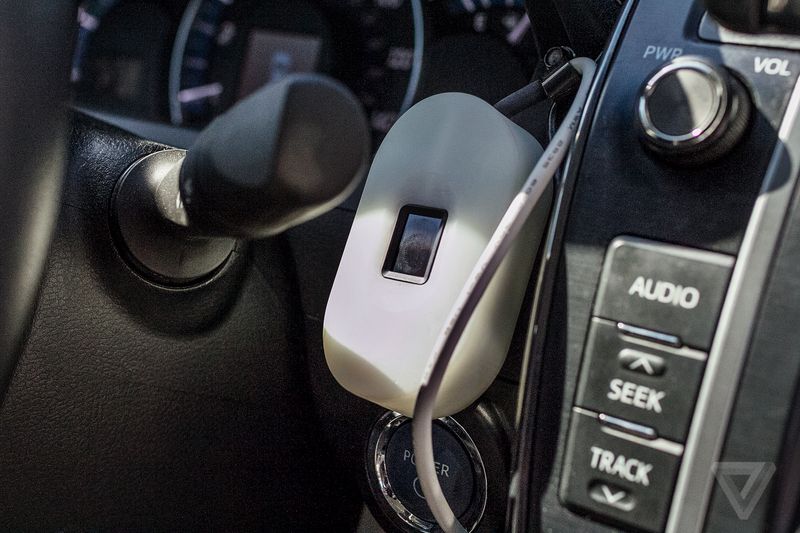Riding in a yellow taxi used to be a miserable experience, which helps explain why Uber and Lyft were able to swoop in and so thoroughly disrupt the industry. Fed up with unreliable and dirty taxi rides, passengers migrated en masse to ride-hail apps that promised cleaner rides, friendlier drivers, and seamless payments. Taxi operators tried to stave off the bleeding by rolling out their own apps — but most were just pale copies of Uber. Now, the traditional taxi industry is launching a new counter-offensive against the ride-hail menace: gadgets.
Starting this year and ramping up in 2017, Verifone Systems — one of the largest payment processing companies in the world — will install new technology in tens of thousands of cabs nationwide, in a massive effort to improve the cab-riding experience for not only riders, but drivers as well. Verifone owns taxi meters, credit card machines, and entertainment systems in dozens of markets in the US, including New York City, where it controls around half of the city’s fleet of yellow and green cabs.
The experience of riding in a yellow taxi is about to get high-tech. Gone are the bulky touchscreen TVs blaring clips from Good Morning America and the analog meters with their retro-red numerical displays. (Regulators in New York City announced last year its plan to phase out the annoying Taxi TVs.) By next year, many of TVs will be replaced with sleek, 10-inch touchscreen tablets with third-party app support. That means riders will soon have the option of streaming Spotify or booking a reservation with Open Table during their cab rides.
There will be a USB charger, because we live in an era when our smartphones always need charging, and Wi-Fi, because data plans are expensive. Credit card readers will also accept mobile payment options like Apple Pay and Samsung Pay. (Four years ago, Verifone tried its hand at mobile payments with its Square-like Sail card reader, only to pull out of the marketmonths later.)
/cdn0.vox-cdn.com/uploads/chorus_asset/file/7153981/adiaconis_160922_1230_0002.0.jpg)
And there will be new toys for the drivers, too. Verifone will be installing 7-inch tablets on the dash that will serve as an all-in-one meter, dispatch, and navigation device. It will use GPS to communicate with satellites to calculate the most accurate fare, but will also include back up software for those times the cab is out of range (i.e., tunnels). The company will install biometric readers next to the ignition for drivers to scan their thumb prints at the start of their shifts. And security cameras and panic buttons will help improve security for both drivers and passengers.
Verifone is calling the new front-of-the-cab experience “Dash” and the back-of-the-cab gadgets “Ryde” — because everything needs a hip, weirdly spelled moniker these days. Dash is currently being tested in Verifone’s cabs in Chicago, Boston, and New Orleans, while Ryde is only being rolled out in New York City for now.
“I like to say that we provide what Uber says it provides,” said Jason Gross, global head of product and marketing at Verifone. “We are a technology platform for the owners and operators of taxis to be connected with passengers who want transportation.”
Gross declined to comment on the total cost for all these new gadgets, but Verifone is a public company that does around $2 billion in annual revenue, so he said the expenditure “would probably be considered non-material.”
Verifone will be rolling out these new gadgets at the same time as competition for space inside most yellow cabs is heating up. Flywheel, an e-hail app based in San Francisco, recently launched its smartphone-based meter-and-dispatch solution in New York City. Flywheel hailed the achievement as the first time a new provider has been allowed to install its technology inside a New York City taxi in 12 years, while crowing about breaking up the “duopoly” of Verifone and its main competitor, Creative Mobile Technologies.
/cdn0.vox-cdn.com/assets/2559219/new-york-city-tlc-taxi-stock1_2040.jpg)
Yellow taxis are placing huge bets on e-hail apps like Flywheel to help lift their fortunes against Uber and Lyft. Verifone has two apps, Curb and Way2Ride, while CMT operates one called Arro. But the success of these apps compared to their better known, more widely used rivals is hard to quantify. (Uber and Lyft use for-hire vehicles like black cars rather than taxis.)
Moreover, yellow taxis across the country are still reeling from the disruption of Uber and Lyft. The value of medallions in New York City have fallen sharply, while fleet owners from coast-to-coast are filing Chapter 11. But Gross sees a silver lining amid all this app-inspired chaos.
“I think the regulatory pendulum is swinging back,” he said. “They’re loosening up some on taxis and they’re cracking down some on the [transportation network companies].”
Waiting for regulators to crack down on Uber is not a real strategy to save the industry. Uber and Lyft have raised expectations among riders, and the yellow taxi industry will need to rise to the challenge if they’re going to survive.
“When you think about the technology before, it was never part of the business to design the user experience,” Gross said. “It was a box with a bunch of buttons on it. This gives us an opportunity to make it beautiful.”
[Source:-The Verge]






